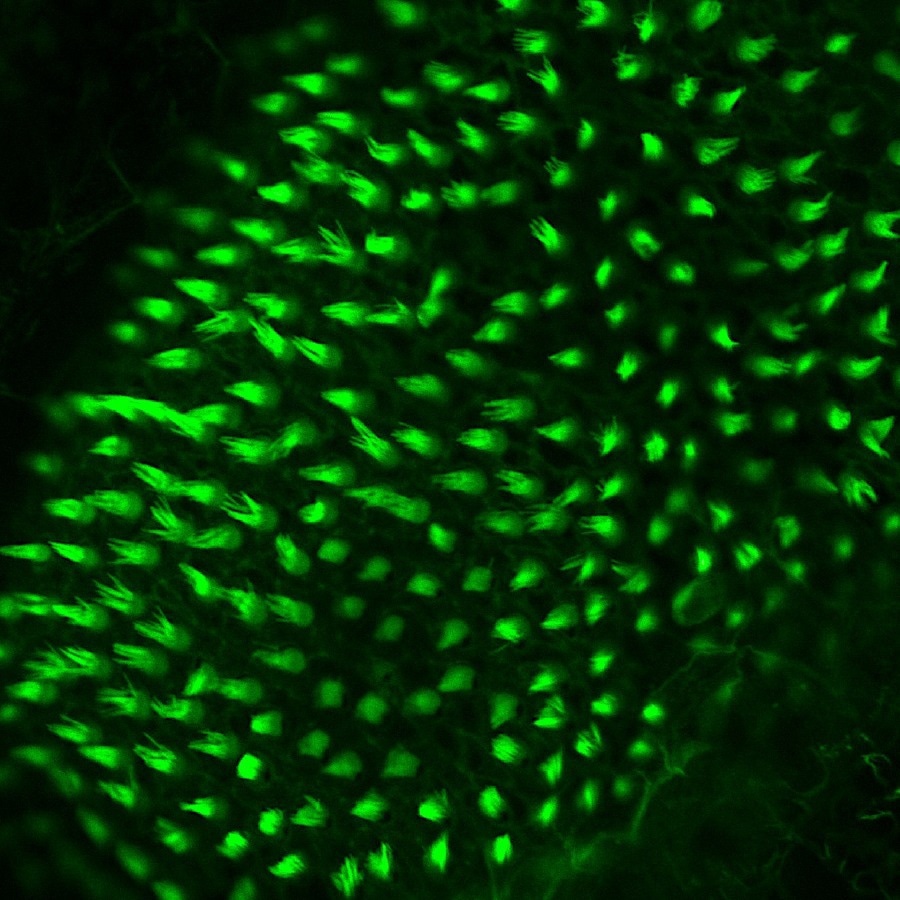Scientists at the National Institutes of Health have identified a particular protein network that is required for cell regeneration to restore hearing in zebrafish. Researchers at the National Human Genome Research Institute (NHGRI) spearheaded the study, which may help in the creation of human hearing loss remedies. Cell Genomics published the findings.
 Confocal image of adult zebrafish hair cells (green) in the auditory organ of the inner ear. Image Credit: Erin Jimenez, Ph.D., NHGRI.
Confocal image of adult zebrafish hair cells (green) in the auditory organ of the inner ear. Image Credit: Erin Jimenez, Ph.D., NHGRI.
Humans cannot grow new hair cells, while many animals, including zebrafish, can regenerate new hair cells after suffering an injury. The ability of zebrafish hair cells to regenerate led scientists to employ this animal to study some basic aspects of regeneration.
About 37.5 million Americans suffer from hearing loss, and the majority of these instances are caused by the degeneration of hearing receptors called “hair cells” in the inner ear. When sound enters the ears, bristles that protrude from these tiny hair cells move and bend, causing electric signals to be delivered through nerves and into the brain that helps individuals to process sound.
Despite having quite distinct appearances, humans and zebrafish have more than 70% of the same genes at the genetic level. Because of this chromosomal commonality, researchers may be able to comprehend the biology of cell regeneration in zebrafish before applying their findings to people.
The study was carried out under the direction of Erin Jimenez, Ph.D., a postdoctoral fellow in the research facility of Shawn Burgess, Ph.D., senior investigator in the Translational and Functional Genomics Branch of the National Human Genome Research Institute (NHGRI), in association with investigators Ivan Ovcharenko, Ph.D., and Wei Song, Ph.D., at the National Center for Biotechnology Information.
Humans and other mammals are born with a set number of hair cells that are slowly lost through aging and trauma. However some animals, such as zebrafish, can regenerate hair cells and recover hearing after injury. How and why regeneration happens in these animals remain a mystery that many scientists would like to unravel.”
Shawn Burgess, Senior Investigator, Translational and Functional Genomics Branch, National Human Genome Research Institute
Jimenez and her colleagues discovered that hair cell regeneration in zebrafish depended on a network of proteins known as transcription factors, which have the ability to switch genes on and off, using a mix of genomic approaches and computational-based machine learning.
The enhancer sequences in the zebrafish genome were the first thing the researchers had to look at to accurately pinpoint which transcription factors were involved.
Enhancer sequences are the ignition switch if transcription factors are compared to the keys used to start and stop an automobile. Both components must work together to make an automobile move, much as transcription factors must bind to particular enhancer sequences to cause a gene to be expressed.
The enhancer sequences and the accompanying transcription factors that are involved in hair cell regeneration were discovered by the researchers utilizing novel genomic approaches termed single-cell RNA sequencing and single-cell assay for transposase-accessible chromatin using sequencing.
Our study identified two families of transcription factors that work together to activate hair cell regeneration in zebrafish, called Sox and Six transcription factors.”
Erin Jimenez, Postdoctoral Fellow, Translational and Functional Genomics Branch, National Human Genome Research Institute
The regeneration response is first triggered in the surrounding cells, known as support cells, by the Sox transcription factors. The transcription factors Sox and Six then work together to transform those support cells into hair cells.
Zebrafish support cells begin to replicate when surrounding hair cells die. Due to their capacity to differentiate into different cell types, support cells are comparable to stem cells. Although some of the mechanisms that cause support cells to develop into hair cells have been discovered, it is still unclear how and where the genes responsible for those factors are activated and how they work with other unidentified factors.
We have identified a unique combination of transcription factors that trigger regeneration in zebrafish. Further down the line, this group of zebrafish transcription factors might become a biological target that may lead to the development of novel therapy to treat hearing loss in humans.”
Erin Jimenez, Postdoctoral Fellow, Translational and Functional Genomics Branch, National Human Genome Research Institute
Source:
Journal reference:
Jimenez, E., et al. (2022) A regulatory network of Sox and Six transcription factors initiate a cell fate transformation during hearing regeneration in adult zebrafish. Cell Genomics. doi.org/10.1016/j.xgen.2022.100170